2006 News
2006 News
2006/12/18
Launch of H-ⅡA Launch Vehicle No. 11
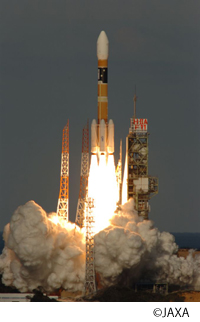
At 3:32 pm on December 18, 2006,
the Japan Aerospace Exploration Agency (JAXA) successfully launched the H-ⅡA Launch Vehicle No.11 (H-ⅡA F11) from the Tanegashima Space Center in Kagoshima prefecture, Japan.
The H-ⅡA F11 inserted the Engineering Test Satellite Ⅷ (Kiku No.8) into orbit.
IHI Aerospace Co., Ltd. was responsible for the development and manufacture of the solid rocket boosters (SRB-As), the pyrotechnics for the separation of rocket stages,
the 2nd stage reaction control gas jets, and apogee engine for the satellite.
We also supported the launch at Tanegashima Space Center.
2006/09/23
Launch of M-V Launch Vehicle No. 7
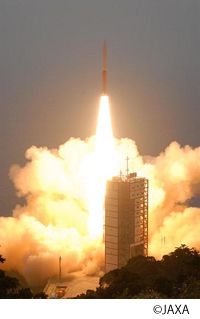
At 6:36 am on September 23, 2006,
the Japan Aerospace Agency (JAXA) successfully launched M-V Launch Vehicle No.7 (M-V-7) from the Uchinoura Space Center in Kagoshima prefecture, Japan.
It carried a solar physics satellite (SOLAR-B) into orbit. Once in-orbit, SOLAR-B was named "HINODE". This launch was the last mission for the M-V Launch Vehicle.
IHI Aerospace Co., Ltd. was responsible for the development and manufacture of the first through third stage solid propellant rocket motors of the M-V launch vehicle as well as the pyrotechnics of its separation system.
We also supported the integration of this rocket.
2006/09/11
Launch of H-ⅡA Launch Vehicle No. 10
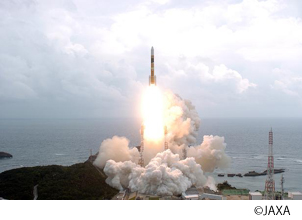
At 1:35 pm on September 11, 2006,
the Japan Aerospace Exploration Agency (JAXA) successfully launched the H-ⅡA Launch Vehicle No.10 (H-ⅡA F10) from the Tanegashima Space Center in Kagoshima prefecture, Japan.
The H-ⅡA F10 inserted an information gathering satellite into orbit.
With this launch, the H-ⅡA has accomplished four successful launches consecutively and has also achieved a cumulative success record of 90%.
IHI Aerospace Co., Ltd. was responsible for the development and manufacture of the solid rocket boosters (SRB-As), the pyrotechnics for the separation of rocket stages, and the 2nd stage reaction control gas jets. We also supported the launch at Tanegashima Space Center.
2006/02/22
Launch of M-V Launch Vehicle No. 8
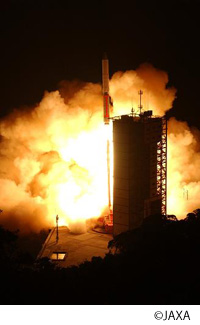
At 6:28 am on February 22, 2006,
the Japan Aerospace Exploration Agency (JAXA) successfully launched M-V Launch Vehicle No.8 (M-V-8) from the Uchinoura Space Center in Kagoshima prefecture, Japan.
It carried an astronomical infrared imaging surveyor (ASTRO-F) into orbit.
The objective of the ASTRO-F is to conduct a Japanese infrared all-sky survey.Once in-orbit, ASTRO-F was named "AKARI".
IHI Aerospace Co., Ltd. was responsible for the integration of the M-V rocket in addition to the development and manufacture of the first through third stage solid propellant rocket motors, and pyrotechnics of the separation system.
2006/02/18
Launch of H-ⅡA Launch Vehicle No. 9
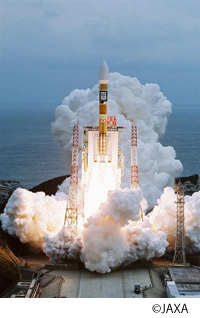
At 3:26 pm on February 18, 2006,
the Japan Aerospace Exploration Agency (JAXA) successfully launched the H-ⅡA Launch Vehicle No.9 (H-ⅡA F9) from the Tanegashima Space Center in Kagoshima prefecture, Japan.
The H-ⅡA F9 inserted the "Multi-functional Transport Satellite"(MTSAT-2) into orbit.
MTSAT-2 is a geosynchronous satellite operated by the Japanese Ministry of Land, Infrastructure, and Transport, and has two missions, an aeronautical mission and a meteorological mission.
Regarding the aeronautical mission, MTSAT is expected to play a key role in increasing airspace capacity and ensuring air navigation safety in the Asia/Pacific region. As regards the meteorological mission, MTSAT-2 will succeed the role of Himawari No.6 , which H-ⅡA F7 launched, when it is retired.
Weighing some 4.65 tons, MTSAT-2 is the heaviest satellite that Japan has ever launched. IHI Aerospace Co., Ltd. was responsible for the development and manufacture of the solid rocket boosters (SRB-As),
the pyrotechnics for the separation of rocket stages, and the 2nd stage reaction control gas jets.
We also supported the launch at Tanegashima Space Center.
2006/01/24
Launch of H-ⅡA Launch Vehicle No. 8
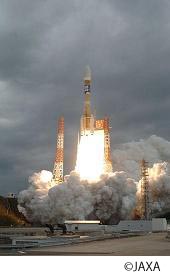
At 10:33 am on January 24, 2006, the Japan Aerospace Exploration Agency (JAXA) successfully launched the H-ⅡA Launch Vehicle No.8 (H-ⅡA F8) from the Tanegashima Space Center in Kagoshima prefecture, Japan.
The H-ⅡA F8 inserted the "Advanced Land Observing Satellite"(ALOS) into orbit.
ALOS (Japanese name is "Daichi") is aimed at obtaining data useful for topography and land use, as well as land information, to produce 1:25000 maps on a global basis.
ALOS is a large satellite weighing some 4 tons with three remote-sensing instruments on board.
IHI Aerospace Co., Ltd. was responsible for the development and manufacture of the solid rocket boosters (SRB-As), the pyrotechnics for the separation of rocket stages, and the 2nd stage reaction control gas jets.
We also supported the launch at Tanegashima Space Center.
2006/01/22
Launch of the S-310-36 rocket
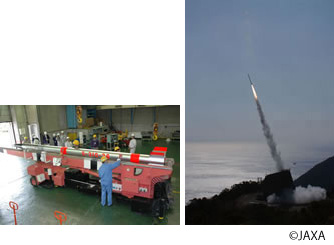
On January 22 at 1:00 pm,
the Japan Aerospace Exploration Agency (JAXA) launched the 36th S-310 rocket (with an overall length of 7.8m and a total weight of approximately. 0.8t)
from the Uchinoura Space Center in Kagoshima prefecture, Japan.
The objective of the launch was to conduct a validation experiment for the deployment of a large net structure in space and the formation of a phased array antenna using this technique.
The concept of attaching daughter satellites to the edges of films or nets and deploying the latter using thrust from the daughter satellites is being studied as one possibility for large space structures of the future.
These technologies will find applications in very large, space-based solar power plants and communication antennas in the future. The rocket separated the payload fairing after 80 seconds of launching, and the antenna began to deploy at an altitude of 117 km after 130 seconds of launching. Antenna formation and other experiments were conducted successfully according to schedule.
After 177 seconds of launching, the rocket reached an altitude of 127 km after which it splashed down in the ocean southeast of Uchinoura.
IHI Aerospace Co., Ltd. is responsible for developing and manufacturing the S-310 rocket.

